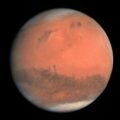A team of astronomers believe that a near earth asteroid could actually be a lost fragment of Earth’s moon. Named Kamo’oalewa, the asteroid is between 150 and 190 feet in size, and regularly comes to within about 9 million miles of Earth.
BACKGROUND: SEEING IS BELIEVING
Kamo’oalewa is part of a group of space objects known as quasi-satellites, because they orbit the Sun but remain relatively close to Earth. Such objects are very dim, and therefore very difficult to see. Discovered back in 2016, this particular quasi-satellite is only viewable from Earth each April. Because of its small size, only the largest of telescopes can spot it.
“These challenging observations were enabled by the immense light gathering power of the twin 8.4-meter telescopes of the Large Binocular Telescope,” said Al Conrad, a staff member at the telescope and one of the study’s co-authors, in a press release announcing the team’s exciting results. Based in southern Arizona, the Large Binocular Telescope is managed by the University of Arizona.
ANALYSIS: WE HAVE A CHUNK OF THE MOON!
Led by Ben Sharkey, a graduate student in planetary sciences, the team looked specifically at the light reflected off of Kamo’oalewa’s surface in an effort to determine its composition. This also helped them determine its likely origin, in this case, the moon.
“I looked through every near-Earth asteroid spectrum we had access to,” said Sharkey, who is also the paper’s lead author, “and nothing matched.”
What did match, however, was the light spectra reflected off of lunar rocks collected during NASA’s Apollo missions back in the last century. The astronomy team notes that there are no other known asteroids of lunar origin, so even trying to determine how it broke off will be difficult.
OUTLOOK: CONFIRMING SATELLITE IS REALLY A MOON ROCK
After missing a chance to double check their initial measurements in Aril of 2020 due to the COVID pandemic, Sharkey and the rest of the team were finally able to confirm their hypothesis with new light spectra measurements in April of this year.
“This spring, we got much needed follow-up observations and went, ‘Wow it is real,'” said Sharkey. “It’s easier to explain with the moon than other ideas.”
The team also confirmed the object’s unusual orbital position, which is at a slight tilt like Earth itself rather than other asteroids.
“It is very unlikely that a garden-variety near-Earth asteroid would spontaneously move into a quasi-satellite orbit like Kamo`oalewa’s,” added Renu Malhotra, a U of A planetary sciences professor and co-author on the study. “It will not remain in this particular orbit for very long, only about 300 years in the future, and we estimate that it arrived in this orbit about 500 years ago.”
As a next step, Malhotra says she and her team are working on another paper to further investigate this asteroid’s unique origins.
Follow and connect with author Christopher Plain on Twitter: @plain_fiction
